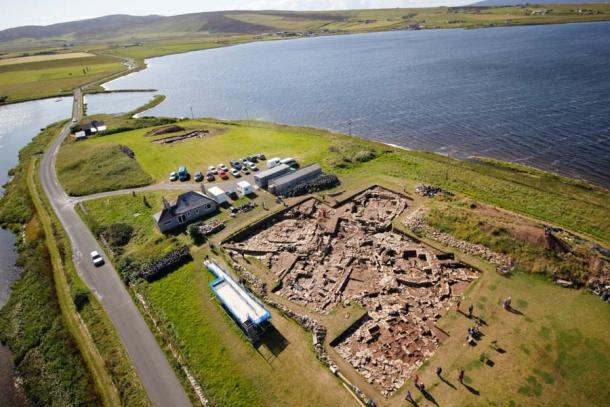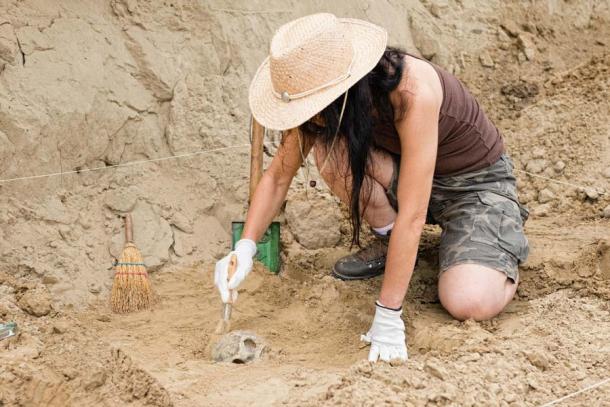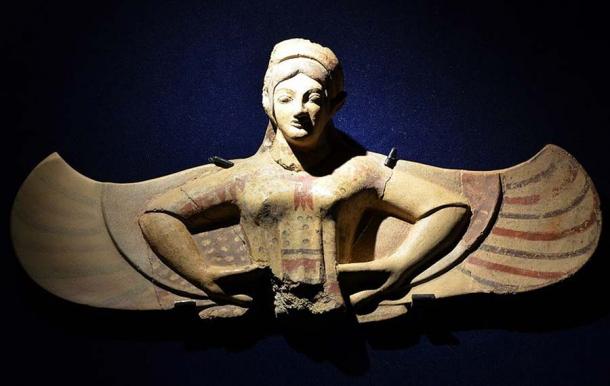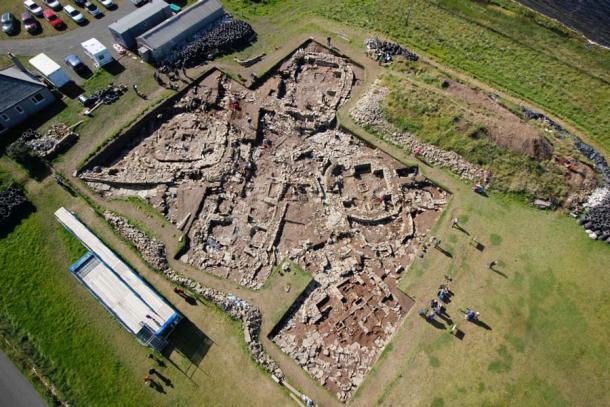Several layers of plastic and geotextile membranes protect the remains of a Neolithic settlement called the Ness of Brodgar in Orkney, Scotland. Large tarps cover the area where the archaeological excavation used to take place, held down by old tires. Underneath, the entire site has been backfilled with 5,000 sandbags to protect the delicate masonry of a massive building complex. Previous excavations have revealed structures dating between 3,300 to 2,400 BC, with finds like pottery, painted walls, bones, and stone tools.
Nick Card, the director of excavations, lives next to the site and often glances out his window to make sure the covers remain in place, especially during high winds. The covers haven’t been removed since the pandemic began, with the excavation cancelled.
A Difficult Time
Archaeological excavations have been facing an array of difficulties during the COVID-19 pandemic. Most digs were either reduced in size or cancelled altogether, and many still haven’t been given the go-ahead to open up again. Those excavations which have been able to proceed face challenges with physical distancing measures, travel restrictions, funding, and more.

Overlooking the main trench at the Ness of Brodgar, facing towards the Stones of Stenness (Hugo Anderson-Whymark)
Archaeologists across the globe are doing their best to adapt and do what excavating they can, even if it’s a fraction of the work they used to do. Archaeology is the restoration and analysis of material remains, a necessary tool for understanding history. Without it, progress cannot be made in recovering the human past.
In any other year the Ness of Brodgar would bring in thousands of site visitors to watch the diggers work. Now, the uncertainty of the pandemic has made it difficult to plan this internationally important excavation. “We’re still very much in the lap of the gods, so to speak, where we just don’t know what’s going to happen,” said Card. “We don’t know what the restrictions will be, what the state of play is regarding vaccine rollout, it’s just too early to say.”

Many excavations are facing cutbacks ( Microgen / Adobe Stock)
In the meantime, The Ness has turned its attention to improving its online presence and sharing the site’s current findings with the world. Card said their biggest achievement has been the publication of “The Ness of Brodgar : As It Stands”, their new interim monograph providing an up-to-date account of the site. The volume was published in November and they sold out within four months. “A thousand copies might not seem like a lot but in archaeological terms, that’s a bestseller,” said Card.
There is plenty of research being done, but the actual fieldwork, which Card described as the jewel in the crown, has been on pause. Card said they will have to decide soon whether to go ahead with excavations this year. Trying to organize excavations of up to 120 staff, students, and volunteers working at once while enforcing COVID-19 regulations is no simple task. “It’s a logistical nightmare,” said Card.
Continuing Work Under Covid-19
Even though some excavations are being allowed to continue, conducting fieldwork while following COVID-19 protocols is challenging. Mary Malainey, an archaeology professor at Brandon University in Manitoba, spent last summer excavating at the Olson site, the remains of a pre-contact agrarian indigenous society, located 15 kilometres south of Melita in southwestern Manitoba. Her student field course at the site was cancelled, but the relatively low case numbers in Manitoba at the time allowed her to undertake a small excavation with other professionals.
Malainey had planned to put in a block excavation of contiguous units around the area of interest, but instead, her team had to space out several smaller units to maintain physical distancing measures between workers. “We’re basically adapting,” said Malainey. “It’s not ideal, but can it be done? Yes.” She explained that it’s best to expose a large area all at once to get a better understanding of the distribution of materials with respect to one another, but COVID-19 safety precautions come first.

Many sites are standing empty ( graceenee / Adobe Stock)
The pandemic slowed down the excavation, which is unfortunate considering the erosion already affecting the site. “We want to excavate and recover as much material as we can before it’s lost,” said Malainey. She explained that the cut bank on the creek passing through the site is collapsing and valuable artifacts, like modified animal bone tools and pottery, are being washed away. “There is an aspect of urgency for us,” said Malainey, as the site can be lost in a few years.
Erosion isn’t the only thing endangering important historic finds. Looting has been on the rise since the start of the pandemic. UNESCO held a meeting on the issue of illegal trafficking of cultural property last June and experts reported there has been an “increase in online sales of cultural goods, mostly from illicit archaeological excavations.”
What does the Future Hold for Discovering the Past
Alicia Gooden, the president of the Manitoba Archaeological Society who also excavated at the Olson site, stated that there is a great need for hard-working, tenacious volunteers to help archaeology survive this pandemic. “We are people who really are passionate and who really care about history, heritage, and archaeology,” said Gooden. “It’s going to be on us to step up and do as much as we possibly can without expecting an economic return, in order to keep this going.”
Archaeology is a costly discipline, which has already been experiencing a decrease worldwide in both public and private funding. “You have to prove to the government that there is a purpose and a value, and get the public involved so they want you,” said Gooden. Since fewer excavations are taking place, fewer new discoveries are being made, and there are fewer opportunities to show governments the benefits that archaeology can provide. A global economic recession because of COVID-19 could pose even further troubles for archaeological funding.
As research funding dwindles, students studying archaeology are facing an uncertain future. University excavations seem to have had the greatest cancellation rate as universities are responsible for their students’ health and safety, stated Raimund Karl, an archaeologist and professor at Bangor University in Wales. This could be detrimental for a generation of students because fieldwork experience is an important pre-requisite for obtaining a job in archaeology.
Maintaining Work on the Ground
Student field courses that were allowed to proceed faced challenges with transportation and travel. “The problem wasn’t the excavation itself, the problem was getting the students to the site,” said Karl. His students usually travel together to their site on a minibus and find accommodation nearby, but COVID-19 would require separate vehicles and separate living quarters for each household. Furthermore, his field school in the U.K. is run with the University of Vienna, but students in Austria had no way of getting into the U.K. “Both the local and the international collaboration fell due to the limitations on travel rather than on the fieldwork itself,” said Karl.
Due to the lack of fieldwork, many archaeology professors have incorporated virtual archaeological digs into their teaching. Nonetheless, digital imitations could never replace the real thing. “It’s a very intuitive process, there’s so much that goes into it that involves sound and smell and these sorts of features that you can’t convey without actually doing it,” said Laura Banducci, the director of finds at the ancient Roman site of Gabii in Italy. Sensory perception in archaeology considers the role that smells, tastes, textures, and sounds played in the decisions of past societies, but not every archaeologist can benefit from such direct, tactile experience in the age of COVID-19.

The Gabii site has produced many valuable artifacts, including this winged harpy (Carole Raddato / CC BY-SA 2.0 )
Brendon Wilkins is the co-founder and projects director of DigVentures, a platform for participatory archaeology. His organization went from excavating 10 sites annually to no excavations at all in March 2020. “Our actual participation numbers once we got digging again in July fell by 75 per cent,” said Wilkins. “Now our online offer expanded by some 3,100 per cent.” For DigVentures, providing online archaeology videos and courses has been remarkably successful in engaging people during the pandemic. Wilkins said he hopes to have excavations start up again later this year but plans to keep the new digital content running as well, embracing a hybrid model of archaeology.
Commercial Archaeology
By way of contrast to academic archaeology, commercial archaeology has been deemed an essential service in many countries. Commercial archaeology is a for-profit business conducted by private firms, done alongside construction projects to salvage any finds before the land is developed. Robert MacDonald, managing partner of Archaeological Services Inc. in Ontario, said that the pandemic delayed their work and reduced their recruitment numbers, but they still completed their field season. The hard part was providing individualized field equipment for every worker, as so much of it is usually shared. “Overall, we seem to be managing exceedingly well with the effects of the pandemic,” said MacDonald.

Another view of the Ness of Brodgar (Jo Bourne)
The field of archaeology has faced major changes since the arrival of COVID-19. Some optimistic archaeologists at this point are making plans to excavate in 2021, while others have already cancelled the field season for the entire year. Conducting limited archaeology in downsized digs following official pandemic guidelines, while publishing more research and using the digital realm to interact with the public, is the new norm. As restrictions continue to change, so too must archaeologists be willing to adjust and adapt.
Top image: The pandemic has led to widespread reductions in excavation activity Source: MarkBuckawicki / CC0.
By Irena Velez
References
Athar Project. Available online: http://atharproject.org/media/
Ness of Brodgar: Investigating a Prehistoric Complex in the Heart of Neolithic Orkney. Available online: https://www.nessofbrodgar.co.uk/
Struck, D, 26/11/2020 COVID-19 even affects the dead; Museums are laying off conservators as pandemic creates cash crunch . Carleton University Macodrum Library
AIA, 24-4-2020 Archaeological Institute Of America Statement On Archaeology And COVID-19 Available online: https://www.archaeological.org/archaeological-institute-of-america-statement-on-archaeology-and-covid-19/
Jarus, O, Live Science Jan. 4, 2021. What archaeology will look like in 2021? Available online: https://www.livescience.com/archaeology-in-2021.html
Milner, George R., Howey, M., Katzenberg, A. 2021, Editorial: Journal Editor Transition and COVID-19 pandemic submissions Journal of Anthropological Archaeology. Available online: https://www.sciencedirect.com/science/article/pii/S0278416521000076?via%3Dihub
Lennox, Rob, Covid-19 Restrictions and Impacts on Commercial Archaeology. Historic England. Available online: https://historicengland.org.uk/whats-new/debate/recent/impact-of-covid-on-heritage/covid-restrictions-impact-commercial-archaeology/
Chartered Institute for Archaeologists, 2020. Coronavirus advice and information Available online: https://www.archaeologists.net/practices/coronavirus
UNESCO, 27/6/2020. Illegal excavations and online trade of cultural property looted in the midst of COVID- 19 Available online at: https://en.unesco.org/news/illegal-excavations-and-online-trade-cultural-property-looted-midst-covid-19
Related posts:
Views: 0
 RSS Feed
RSS Feed

















 May 15th, 2021
May 15th, 2021  Awake Goy
Awake Goy  Posted in
Posted in  Tags:
Tags: 
















